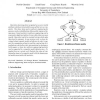Free Online Productivity Tools
i2Speak
i2Symbol
i2OCR
iTex2Img
iWeb2Print
iWeb2Shot
i2Type
iPdf2Split
iPdf2Merge
i2Bopomofo
i2Arabic
i2Style
i2Image
i2PDF
iLatex2Rtf
Sci2ools
ASWEC
2007
IEEE
2007
IEEE
Supporting OO Design Heuristics
Heuristics have long been recognised as a way to tackle problems which are intractable because of their size or complexity. They have been used in software engineering for purposes such as identification of favourable regions of design space. Some heuristics in software engineering can be d in high-level abstract terms while others are more specific. Heuristics tend to be couched in terms which make them hard to automate. In our previous work we have developed robust semantic models of software in order to support the computation of metrics and the construction of visualisations which allow their interpretation by developers. In this paper, we show how software engineering heuristics can be supported by a semantic model infrastructure. Examples from our current work illustrate the value of combining the rigour of a semantic model with the human mental models associated with heuristics.
| Added | 02 Jun 2010 |
| Updated | 02 Jun 2010 |
| Type | Conference |
| Year | 2007 |
| Where | ASWEC |
| Authors | Neville Churcher, Sarah Frater, Cong Phuoc Huynh, Warwick Irwin |
Comments (0)

